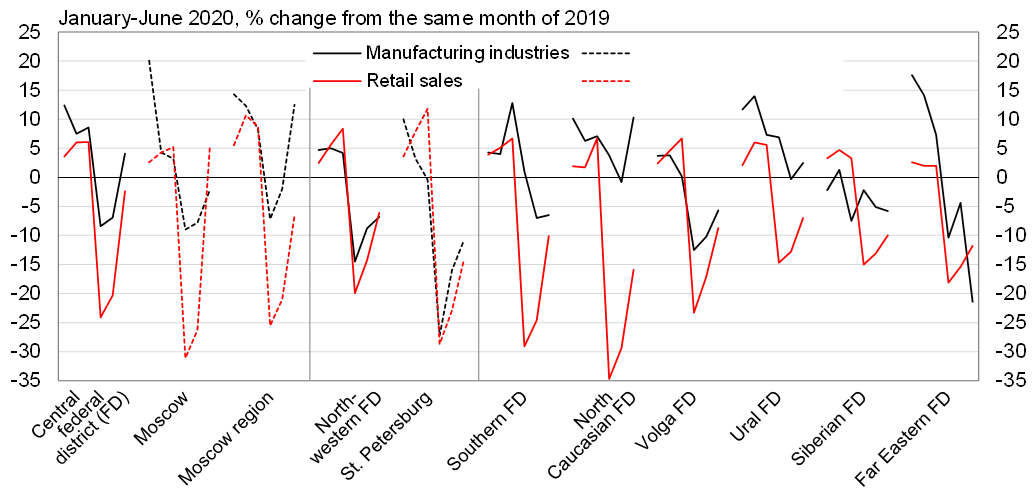BOFIT Weekly Review 33/2020
Declines in industrial output vary across Russian regions; retail sales making comeback from depths
Total industrial output, which comprises extractive industries and manufacturing, recovered in Russia’s Central Federal District in June to the same level as in June last year. The Central Federal District includes Moscow, where production has recovered to levels well above a year ago. In nearly all other federal districts as well as the City of St. Petersburg, industrial output has shrunk more, by about 10 % y-o-y, with neither May nor June bringing much respite.
In extractive industries, which include oil & gas production as well as support services, industrial output was down in Russia in May-June by 15 % y-o-y. The decline was about the same in the Tyumen region, which is part of the Ural Federal District and accounts for more than a third of Russia’s extractive industry activity. Production also fell tangibly in several other fairly significant regions of mineral extraction, including Tatarstan and the Orenburg region in the Volga Federal District, the Krasnoyarsk region in the Siberia Federal District and the Sakhalin island in the Far East Federal District.
Manufacturing output has declined widely across Russia, falling in about 60 of the country’s more than 80 administrative regions during April-June. Due to recoveries, manufacturing output in June was down on-year in no more than about 40 regions. Large drops were seen in the Northwestern Federal District due to a deep dive in output in the City of St. Petersburg, along with the Volga and Far East Federal Districts. Clear output recoveries were also seen in the Northwestern and Volga Federal Districts.
Besides the broad-based downturn in manufacturing, the output figures for several regions and even Russia’s national manufacturing figure, have been impacted notably by reduced production in several hubs of certain large manufacturing branches. First, car production collapsed in spring in five significant regions, i.e. the City of St. Petersburg, and the regions of Nizhni Novgorod, Samara, Kaluga and Kaliningrad. Second, production of petroleum products declined precipitously in four important regions: Nizhni Novgorod, Omsk, Bashkiria and Moscow. Third, metal production contracted considerably in three regions: in the Chelyabinsk, Krasnoyarsk and Sverdlovsk regions.
Only one of Russia’s over 80 regions avoided a sharp drop in retail sales in spring after the imposition of restrictions during the government’s initial response to the coronavirus pandemic. In June, retail sales in just 14 regions had recovered to the same levels as in June 2019. Most of the recovery seen in the Central Federal District in June was driven by the resurgence of retail sales in Moscow. In six other federal districts, June retail sales were down by 6−12 % y-o-y.
Manufacturing and retail sales have recovered in most of Russia’s federal districts and largest urban concentrations

Sources: Rosstat and BOFIT.